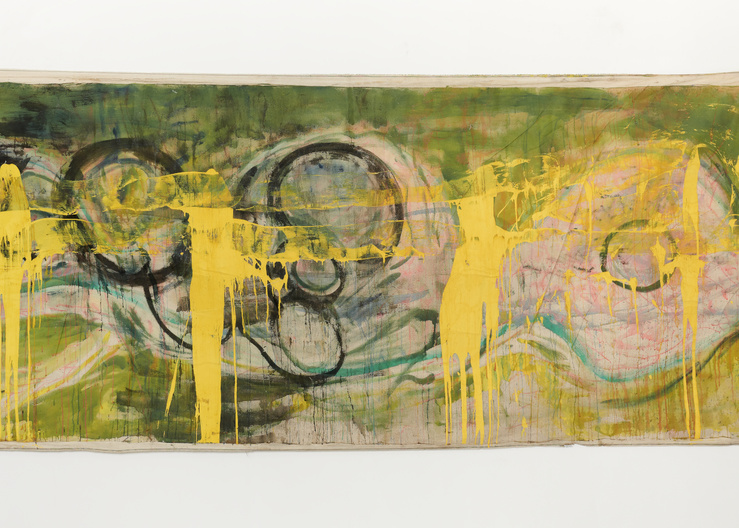
Vivian Suter — Palais de Tokyo
At the Palais de Tokyo, the exhibition devoted to Vivian Suter immerses us in a pictorial universe of rare density—organic, free, and deeply sensory.
Vivian Suter — Disco @ Palais de Tokyo from June 12 to September 7. Learn more The artist, who has lived in the Guatemalan jungle since the 1980s, presents a prolific body of work in which canvas becomes more than a medium: it draws a litany of living motifs across space, turning the curatorial gesture into a thoughtful reflection of the artist’s own practice. Suter’s canvases quite literally inhabit space. Suspended, at times piled up, splattered with mud or rainwater, they are alive. This is painting meant to be touched as much as seen—a painting without frames, without hierarchy, where gestures explode in all directions. Here, formal freedom merges with the artist’s material freedom—liberated from the expectations of an art world she has long engaged with from its periphery.The exhibition draws a moving parallel with the work of her mother, Elisabeth Wild, also an artist, whose meticulous collages counterbalance Suter’s lyrical overflow. This mother-daughter dialogue adds particular depth to the ensemble, quite literally weaving art into the family lineage—especially when one learns that the exhibition’s title, Disco, is also the name of the artist’s dog, definitively dissolving the boundary between life and art.
From her inner garden, Vivian Suter offers the plans of a vast communal park, as humble as it is lush. Behind the seemingly abstract gestures, forms emerge—stylized plants, solar circles, silhouettes at times. The circle asserts itself as an obsessive matrix, endlessly repeated, punctuating and structuring the scattered surfaces with rhythmic syncopation. There is a constant tension between vibrant contrasts—at times nearly expressionistic—and the delicacy of more impressionistic gestures, as if hastily sketched. This perpetual imbalance gives rise to a paradoxical equilibrium: a painting in suspension, in motion, whose emotional charge lies less in immediate impact than in spatial expansion and, by extension, temporal extension.
It echoes a mixed feeling that inhabits the viewer—likely more impacted by the exhibition’s staging, its ambition and generosity, than by the works themselves, which are not sufficiently contextualized within the history of painting they so directly engage. On this vast and generous stage, Suter’s works vibrate and burst forth with clarity. Yet their construction—often more complex than purely instinctive—does not erupt with the expected force.
Still, what remains is an undeniable sense of commitment and involvement which, beyond any desire to seduce or soothe, becomes a mirror of a gaze perpetually anchored in a landscape and a life it never ceases, in its own way, to celebrate—offering through its materiality a universally resonant presence.









